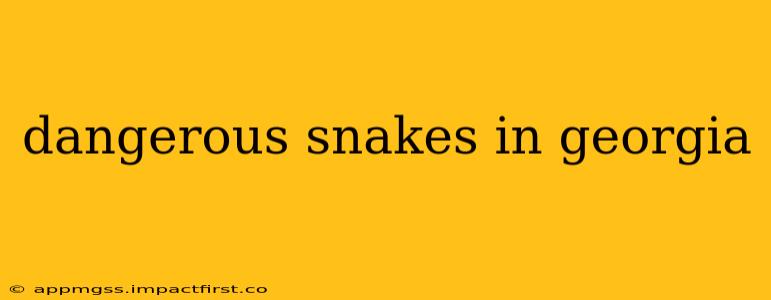Georgia boasts a diverse ecosystem, and with that diversity comes a variety of snake species, some of which are venomous and potentially dangerous to humans. Understanding which snakes pose a threat and how to react in an encounter is crucial for anyone living in or visiting the Peach State. This guide provides a detailed overview of the dangerous snakes found in Georgia, focusing on identification, habitat, and what to do if bitten.
What are the most venomous snakes in Georgia?
Georgia is home to several venomous snakes, but four stand out as posing the most significant threat to humans: the copperhead, cottonmouth (water moccasin), pygmy rattlesnake, and timber rattlesnake. Each possesses a distinct venom that can cause severe medical issues. While the venom's potency varies between species and individuals, all require immediate medical attention.
Copperhead (Agkistrodon contortrix)
- Identification: Copperheads are identified by their hourglass-shaped markings on their back, copper-colored heads (although this can vary), and relatively small size (2-3 feet). Their color ranges from reddish-brown to tan.
- Habitat: These snakes are common throughout Georgia, inhabiting forests, fields, rocky areas, and even suburban environments. They are often found near human dwellings.
- Venom: Their venom is hemotoxic, causing pain, swelling, and tissue damage. While rarely fatal, medical attention is absolutely necessary.
Cottonmouth (Agkistrodon piscivorus)
- Identification: Also known as water moccasins, cottonmouths have a thick body, dark, often grayish-brown or black coloration, and a characteristic white or pale interior of their mouth, which they display when threatened.
- Habitat: As their name suggests, they are primarily found near water sources like rivers, swamps, and lakes, but can also venture into drier areas.
- Venom: Their venom is hemotoxic, causing similar effects to copperhead venom but potentially more severe pain and tissue damage.
Pygmy Rattlesnake (Sistrurus miliarius)
- Identification: This small rattlesnake (under 2 feet) is distinguished by its small size, dark brown or grayish-brown body with dark crossbands, and a tiny rattle. It’s often mistaken for a harmless snake due to its size.
- Habitat: They prefer sandy areas, pine forests, and fields, often found in relatively dry habitats.
- Venom: While their venom is potent, the small amount injected typically results in less severe effects than other rattlesnakes. However, medical treatment is still required.
Timber Rattlesnake (Crotalus horridus)
- Identification: The largest venomous snake in Georgia, the timber rattlesnake can grow over 6 feet long. It has a dark grayish-brown or black body with dark crossbands and a prominent rattle.
- Habitat: These snakes prefer rocky, wooded areas, especially in mountainous regions.
- Venom: Possessing a potent hemotoxic venom, this snake’s bite is a serious medical emergency and can lead to severe complications without prompt treatment.
What should I do if I see a venomous snake?
Avoid all contact. Give the snake ample space, and slowly back away. Never try to handle or kill a venomous snake. The safest course of action is to leave it alone.
What should I do if I'm bitten by a venomous snake?
Remain calm. Panic will only increase your heart rate and potentially spread the venom more quickly.
Seek immediate medical attention. Call 911 or go to the nearest emergency room.
If possible, try to identify the snake (take a photo if safe to do so), but your safety is paramount. Do not attempt to catch or handle the snake.
Keep the affected limb still and below the heart. Avoid excessive movement.
Do not apply a tourniquet, ice, or attempt to cut the wound or suck out the venom. These outdated methods can cause more harm than good.
Are there any other dangerous snakes in Georgia?
While the four snakes mentioned above are the most dangerous, other species can inflict painful bites, including various non-venomous snakes that may bite defensively. However, their bites rarely cause serious medical complications.
How can I prevent snake bites in Georgia?
- Wear protective clothing when hiking or working outdoors.
- Keep your yard clear of debris and overgrown vegetation.
- Be aware of your surroundings when walking through tall grass or wooded areas.
- Never put your hands or feet into places you cannot see.
- Never handle or try to capture a snake.
This comprehensive guide provides a solid overview of dangerous snakes in Georgia. Remember, prevention is always the best approach. By understanding the risks and taking appropriate precautions, you can significantly reduce your chances of encountering a dangerous snake and minimize the potential for a serious snakebite. Always consult with a medical professional for any snakebite related concerns.
